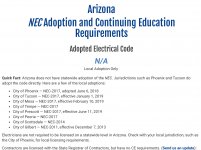This is an excerpt from the June, 1914 issue of the Journal of the Western Society of Engineers, pg. 613-614:
"V. H. Tousley (Chief Electrical Inspector, Chicago) : Mr.
Glover has told us something about the Underwriters ' Laboratories .
After the laboratory has finished with its part of the work, the fittings
are ready for the inspectors in the field . These inspections
are carried on throughout the country, in some cases by the Underwriters,
in some by the individual insurance companies, in some by
the lighting companies, and in other cases by the municipalities .
My remarks will be from the standpoint of the municipality, and
will be confined entirely to the work of the Inspection Bureau, which
covers practically all the work done in the city of Chicago . The
Underwriters have their own inspectors, but they make no pretense
of covering all the work .
Probably very little is known in a general way as to what the
work of the Electrical Inspection Bureau of the City of Chicago
covers. I notice there are men here tonight who are closely connected
with it and who are probably very familiar with it , but the
general electrical man knows little or nothing about the operation of
the municipal Inspection Bureau . I think it is not given the attention
or the support it deserves.
Chicago at the present time maintains an Inspection Bureau
that has 71 employees : 45 of those employees are inspectors working
out in the districts . The appropriation for 1914 is $ 123,860 . That
means Chicago taxpayers are contributing $ 124,000 in 1914 to ensure,
or to attempt to obtain, safe electrical installations .
Chicago has been in the business of inspecting installations for
over thirty years. On the 10th of last December a banquet was
given the Bureau itself to celebrate the thirtieth anniversary of the
passage of the ordinance which created the Bureau . Thirty years
dates back to 1883 and you know that 1883 was pretty young so far
as electrical development was concerned . It is a noteworthy fact
that the book of rules referred to by Mr. Glover was first put together
in Chicago . In 1893 (World's Fair year ) , there was a
meeting of a number of the interested persons , mostly, if not almost
entirely, representatives of insurance companies , who got together
and made up a set of rules . That was the beginning of our present
National Electrical Code. The people who were at this meeting
were not Chicago people alone, but Chicago has the honor of
being the birthplace of the National Electrical Code.
A little idea of the extent of the work of the Inspection Bureau
will be gained from the following figures, which cover the work of
1913. In 1913 there were 114,686 inspections . There were 59,265
permits , which covered the inspection of 2,424,313 incandescent
lights , 239,000 horse power motors , besides a tremendous lot of
other apparatus.
The inspectors are divided into various divisions :
For interior work.
For outside work.
For electric signs .
For theaters .
For reinspection of old installations .
For examination of moving picture operators .
For investigation of electrical accidents ."


